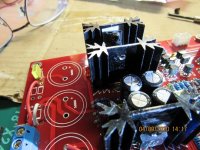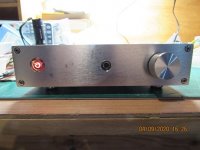The are 4700uF/35V Nichicon electrolytic cap from a US ebay seller (a.mg-3) in Texas.What are you using for main filter capacitors?
2 PCS 4700UF 4700mfd 35V Electrolytic Capacitor 105 degrees USA FREE SHIPPING | eBay
I am kicking myself today. The original toroidal transformer was purchased from a seller in China. I got 2 awhile back and they look like good quality.The upgrade with a regulated PS is finished. I used a simple pair of L7815/L7915. The picture show the stock form PCB vs. the modified PCB for the regulated PS. There are 4 jumpers in red for the positive PS side and one in white for the negative side.
View attachment 688631 View attachment 688632
The good news is it works and the hum is greatly reduced to almost inaudible level. The bad news is the hum is still barely noticeable. But it is so low that I can ignore it. It took me only 2 years to finish this project. In between, I retired from my day job and moved from St. Louis to Chicago.
The sound driving a Sennheiser HD-600 is wonderful with a good depth of the sound stage. It is particularly good when listening to symphonic music where the orchestra is projected in front of me, not in the head. The regulated PS also give a more authoritative bass. The overall sound is very open and similar to the unmodified board.
The quality of the E19 PCB turned out to be very good with dual surface trace and plated through holes. It was a real struggle to removed the 4 6800uF main filter capacitors. The headphone amp did not work when I put it back together the first time. I eventually found that one of the plated through hole was damaged and cut off the 12V supply to the protection relay. I added an extra jumper and everything are fine.
One side note on the L7815/L7915 regulators. I purchased 10 of each with the intention of selecting the best matched pair. Alas, the L7815/L7915 are 0.4 volt apart on the average. The lowest 7815 output is 0.2 volt higher than the highest 7915. Fortunately, the E19 seems to have very good CMRR. Despite the unbalanced PS, the output DC offset is only 1 mV on one channel and 9 mV on the other without trimming.
The schematic of the PS that I used. It is a kit PS that I have idle on my work bench for many years.
View attachment 688641
The E19 board has very well designed amplifier topology. The circuit board construction is very good. But the ground loop in the PCB layout is terrible as nattawa pointed out earlier.
I recently get some toroidal transformers from Antek in US, which are much cheaper due to US shipping. I replaced the transformer in the E19 headphone amplifier box with an Antek 25VA/20+20V one. All traces of hum are gone. The E19 headamp is now dead quiet. I wish I try that a long time ago. Oh, well.
I found the hum problem of the Chinese toroidal when I used one to build a linear power supply for a DAC I just got. Well, a $50 purchase down the drain, but I new get very quiet PSU using the Antek units.
Since I discover the transformer issue after I modified the board and added regulated PSU, I would not have known how to answer your question. I would not have suspected the transformer if it did not produced hum with the linear PSU I built for an ES9038Q2M based DAC. In both cases, the hum disappeared after I substituted the transformer with units from Antek.Does that mean that the E19 board was fine all along, just a transformer that was made poorly?
Or is it indeed required to improve the grounding within the board?
It is possible that the E19 board might have been fine, but I have no proof of it. I did not modified the grounding. The hum was barely detectable after I add the regulated linear PSU.
I have purchased a HA-5000 clone kit which I no longer want. Interested at 20% off?
The DAC may have better hum rejection because it is also hum free with a switching PSU (power brick). The hum was pretty loud even with a regulator for the linear PSU. But the transformer change gets rid of the hum completely.
Last edited:
I had forgotten about how the main filter caps were said to have been in series, so it’s not likely to have worked (as well) without some extra work. Still probably worth the effort, the other board that this one appears to have copied works very well.
Am doing good for headphone amps/pre amps at the moment, otherwise I would consider taking the ha5000 off your hands, thanks for the offer.
Am doing good for headphone amps/pre amps at the moment, otherwise I would consider taking the ha5000 off your hands, thanks for the offer.
Toshiba 2sk2013+2sj313 and latest update
After enjoying the E19 headphone amp for 3 years, I did another round of upgrade. The reason is simple:
1. EUVL (Patrick) comment in post #47 planted a bug in my head even though the amp sound fine to me. What would happen if I get better output devices?
I want a beefier power supply. I replaced the LM317/337 board with a pair of L1083CP which has similar noise in output but much higher current capacity. I increased the output voltage from +/-18V to +/-21V. The new PSU board is larger so I also have to replace the C2205 enclosure to T2205 which is 2cm deeper. The regulator IC temperature dropped from 115 to 85°F. The drop is not necessary, but just nice to have.
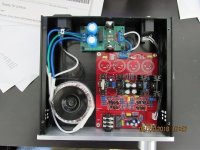
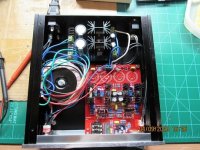
The main course is the replacement of the output transistors with 2 pairs of 2SK2013/2SJ313 which are TO-220 lateral MOSFET designed for audio application. The E19 board is a well constructed 2-sided PCB. Removing the 2SK2381/2SJ407 should be carefully done. I strongly recommend a strong suction desoldering iron and lots of desoldering wick. Carefully remove all trace of solder from the through hole and avoid PCB damage.
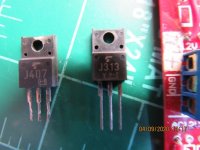
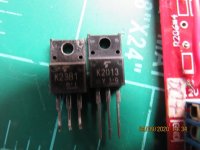
I removed the MOSFET one at a time and inserted the new transistor in place. The original MOSFET was mounted dry. I put thermal paste at the back of the new one before inserting them in place. No soldering was done yet.
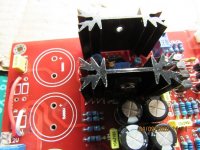
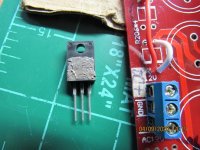
The PCB was flipped over and soldering and trimming were done. I examined the solder carefully with a magnifier to assure all through holes are properly filled. A blast of the flux cleaner finish the board upgrade.
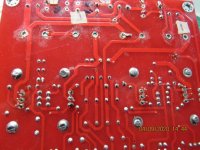
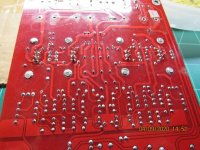
After reassembling, I plugged it in and turn on for an hour. The bias current is right where it was at 60mA. I trimmed the input a little to get DC offset to less than 1mV. The MOSFET case temperature are 105-110°F, same as before.
Take the E19 upstair and plug in the Sennheiser HD-600. It sounds normal. Any improvement is not obvious in my first impression.
After enjoying the E19 headphone amp for 3 years, I did another round of upgrade. The reason is simple:
1. EUVL (Patrick) comment in post #47 planted a bug in my head even though the amp sound fine to me. What would happen if I get better output devices?
2. I have been working on repairing a Sherwood S-6040CP power amp without any progress for several weeks. Replaced many parts. I need a short project that is guarantee to success for change of scenario.A few comments, just stumbled into this by accident :
uPC1237 is meant for loudspeaker protection, and has a trigger point at +0.7/-0,2V.
One can decide whether it is high or not, but I guess most over-ear phones should survive 0.7V DC.
In any case some protection is better than none.
On 2SK2381 / 2SJ407, we got curious, bought some, and curve traced them.
They are one of the most horrible curves we have seen.
They were traced with a triangular wave form (linear current ram) at 100Hz.
So it is just normal operating condition.
You can see that the positive and negative swings followed completely different curves, with a huge hysteresis.
So that was end of story for us. The 5 pairs we bought went to the bin straight after.
You always get what you pay for.
Patrick
I want a beefier power supply. I replaced the LM317/337 board with a pair of L1083CP which has similar noise in output but much higher current capacity. I increased the output voltage from +/-18V to +/-21V. The new PSU board is larger so I also have to replace the C2205 enclosure to T2205 which is 2cm deeper. The regulator IC temperature dropped from 115 to 85°F. The drop is not necessary, but just nice to have.


The main course is the replacement of the output transistors with 2 pairs of 2SK2013/2SJ313 which are TO-220 lateral MOSFET designed for audio application. The E19 board is a well constructed 2-sided PCB. Removing the 2SK2381/2SJ407 should be carefully done. I strongly recommend a strong suction desoldering iron and lots of desoldering wick. Carefully remove all trace of solder from the through hole and avoid PCB damage.


I removed the MOSFET one at a time and inserted the new transistor in place. The original MOSFET was mounted dry. I put thermal paste at the back of the new one before inserting them in place. No soldering was done yet.


The PCB was flipped over and soldering and trimming were done. I examined the solder carefully with a magnifier to assure all through holes are properly filled. A blast of the flux cleaner finish the board upgrade.


After reassembling, I plugged it in and turn on for an hour. The bias current is right where it was at 60mA. I trimmed the input a little to get DC offset to less than 1mV. The MOSFET case temperature are 105-110°F, same as before.
Take the E19 upstair and plug in the Sennheiser HD-600. It sounds normal. Any improvement is not obvious in my first impression.
Attachments
Last edited:
Patrick, thank you for your comment. I still have my older Sennheiser HD 598. 50R, higher sensitivity, phone. I will try that with my upgraded E19 and see how I feel.A 300R phone does not draw current.
A 30R phone will make the thermal hysteresis (or the lack of) more noticeable.
And of course the K2013/J313 has ~3x less transconductance than the K2381/J407.
So not a 1:1 replacement.
Cheers,
Patrick
So far, I like the K2013/J313 E19 with Sennheiser HD 600 just fine. It is a cheap weekend fun I can afford during this coronavirus time.
Last edited:
I have listen to various music by 2 longer session since I finished the update. The sound is excellent like it was before. No, my TIN ears do not hear much difference, if any.
It always has a good sound stage. With good source material, the stage is in front of me, not in my head. It has very extended frequency response. The dynamic range is good. In term of bass and high end frequency, it is not as musical as my Superex electrostatic E-79. I believe it is more a phone, not an amp, factor.
With a $30 e-bay board plus another $100 investment (case, transformer, PSU and output MOSFET), I get the performance I am looking for and the joy of putting the parts together. No, it is not a state of the art headphone amp at bargain basement price.
Anyway, it was a good weekend project that turned into almost a full week.
It always has a good sound stage. With good source material, the stage is in front of me, not in my head. It has very extended frequency response. The dynamic range is good. In term of bass and high end frequency, it is not as musical as my Superex electrostatic E-79. I believe it is more a phone, not an amp, factor.
With a $30 e-bay board plus another $100 investment (case, transformer, PSU and output MOSFET), I get the performance I am looking for and the joy of putting the parts together. No, it is not a state of the art headphone amp at bargain basement price.
Anyway, it was a good weekend project that turned into almost a full week.
- Status
- This old topic is closed. If you want to reopen this topic, contact a moderator using the "Report Post" button.
- Home
- Amplifiers
- Headphone Systems
- E19 headphone amplifier board K2381 J407 MOSFET Yuanjing Audio
